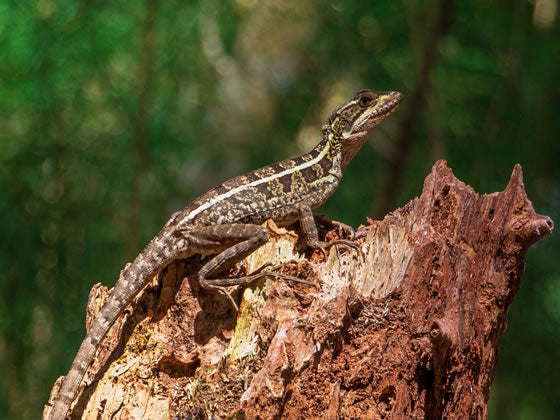Free Delivery
On order over £99*
The common basilisk is a long and thin lizard found in tropical regions of Mexico, Central America and Columbia. The basilisks colouring is usually brown and beige with yellow or orange stripes starting from the head and moving along the top of the abdomen. Males of the species are generally larger and have large plumes on the head, back and tail.
This basilisk will spend most of its time in trees above or around large bodies of water. When threatened the basilisk can rear up on its hind legs using its tail to keep it steady as it runs away extremely quickly. The common basilisk can also dive into water to attempt to avoid predators. One of the most interesting aspects of this basilisk is that it has hydrophobic scales on the underside of its feet which allow it to run for short times over water.


Common basilisks come from a very warm environment so they struggle with the colder climate in the UK and require heating and lighting to thrive. To insulate against the cold and help keep temperatures consistent we recommend keeping a brown basilisk in a wooden vivarium. Due to the temperature gradient required for this species we recommend an enclosure as close to 4 x 2 x 3ft (width x depth x height) as possible for an adult.
When selecting the vivarium, we look for an enclosure with numerous large vents and glass sliding front doors. All of this ventilation should ensure that heat is lost from one side of the enclosure to the other while keeping the basking spot itself at a consistent temperature.
Younger basilisks may feel exposed and frightened in large open spaces so we make sure to include a lot of decorations. These can be removed as the basilisk grows in size and gets used to its environment, providing more space to move around and bask within the enclosure.
In the wild, the common basilisk will spend a lot if its time basking in the sunlight. As such they require a very warm basking area of 32℃ to 35℃ (90℉ to 95℉) during the day time. We aim to provide this heat over 1/3 of the enclosure while letting the rest of the enclosure cool to room temperature on the opposite side. To achieve this, we attach a strong basking lamp to the ceiling on one end of the enclosure. This is controlled by a high temperature dimming thermostat to make sure that the temperature is kept correct and consistent throughout the day. The basking lamp is left on for 10-12 hours per day.
At night, all of the lights should go off and the enclosure should be completely dark. This will make sure that the basilisk has a clear day and night cycle.
During the night time the enclosure should get cooler but we still provide some warmth throughout the night. We aim for a temperature gradient of 27℃ (80℉) on the hot end down to room temperature on the other side. To provide this warmth throughout the night without introducing light to the enclosure we attach a ceramic lamp to the ceiling in the back corner of the warm end of the enclosure. This lamp is surrounded by a guard and controlled by a pulse thermostat to make sure that it stays at the correct temperature throughout the night. Ideally, we would like 1/3 of the enclosure to remain warm allowing the rest of the enclosure to drop down to room temperature.
If you would like the heating and lighting to run automatically you could use a mechanical timer with your UVB tube and basking lamp. As the ceramic heater is set to a much lower temperature than the basking lamp it can be left on all of the time. Your thermostat will only provide power to the ceramic heater when the enclosure drops below the set temperature (27℃ / 80℉). By leaving the ceramic on and controlled by a thermostat you are also introducing a redundancy. If the basking bulb were to blow while you are away from the enclosure, the ceramic heater would take over and keep the enclosure warm until you could intervene.
Though the thermostats we sell are very reliable it is always best practice to monitor your temperatures with a thermometer. A 3℃ (5℉) variance on the basking spot is nothing to worry about as long as your cool side is still cool. A simple dial thermometer on each side should be sufficient but digital probe thermometers are much more accurate.


As described in the previous section, a wild common basilisk will spend a lot of its time basking. During this period, the basilisk is exposing itself to plenty of warmth and UVB. While this species will bask for a long portion of the day, they are often in the partial shade of the canopy and as such they don't need quite as much UVB as other basking species.
To aid in deciding which intensity UVB is required for each species, UVI readings have been taken in their natural habitat. These readings are compiled over time to get an average exposure reading which sits in one of 4 distinct ranges called Ferguson zones. Zone 1 animals get very little UVB exposure, Ferguson Zone 2 consists of partial baskers, zone 3 are basking reptiles and zone 4 animals bask in UVB intense environments. Brown basilisks are recorded as basking in Ferguson zone 2 (UVI 0.7-1.0).
In the same way we allow a little variance in the temperature of the basking spot we would not worry too much if the UV exposure is a little too strong at the closest point. As long as there is a gradient present the basilisk will place itself in the perfect position.
UV tubes are currently available in 2 sizes, T8 and T5. The T8 lamps are around 1 inch in diameter, they must be replaced every 6 months or so and they have an effective range of 9-12 inches. T5 lamps are the newer iteration. They are around half an inch in diameter, they must be replaced every 12 months and have an effective range of 18-24 inches.
For taller enclosures we would always recommend a T5 unit and for this species a Zone 2, 5% or 6% UVB tube. When mounted around 30cm from the main basking spot these UVB tubes should provide the correct basking zone. The UVB unit should be mounted to the ceiling close to the back wall. This configuration will provide a nice UV gradient from the back of the enclosure towards the front and from the top of the enclosure to the bottom. With the UV and basking lamp set up this way we achieve a temperature gradient along the width of the enclosure and a UV gradient along the depth of the enclosure. This means that whatever the basilisk's requirements they can find the perfect position within the enclosure.
Though the brown basilisk is a basking species it may desire some time during the day in an area with little to no light. To allow this we advise providing partial and full hiding spots throughout the enclosure.
Common basilisks thrive in mid to high humidity environments with absorbent decorations to climb over and bask on. When selecting a bedding we try to ensure that the pieces will absorb the moisture from the morning spray and release it throughout the day. In our store we normally use a coarse bark woodchip as it is clean, cheap and easy to spot clean. If you prefer a more natural looking decoration a soil / moss mix would be perfect. If you plan to keep the basilisk in a bio-active enclosure a nutrient rich soil mix with a drainage layer below it would be best. In any case, it is important to make sure that the vivarium's joints and any exposed board is sealed with a aquarium grade sealant. This will ensure that moisture cannot seep into the enclosure, warp the panels or rot the wood over time.
To allow the basilisk to take full advantage of the UVB and heat gradients we have created it is important to provide plenty of hard wood decorations that can support the weight of the basilisk. We advise allowing the basilisk to get as close as 6 inches to the basking bulb and UVB tube so that it can have access to both intense heat and UV. While the basilisk is unlikely to bask in this position often it will venture there for short periods as required. We have found that the best branches to create this structure are tronchos, grapevine and cork oak branches. If you would like to secure them to each other you can do so with zip ties or bendable jungle vine but you must take care to ensure that the basilisk can't get stuck in any gaps left in the loops created.
Brown basilisks love the warmth coming from their basking lamp but they also appreciate secondary surface heat which will radiate from warm objects. Natural rocks like slate are perfect for this, as are heavy artificial ornaments. These decorations can be placed under and around the basking area and should warm up throughout the day. If the decoration is too close to the basking lamp there is a chance that natural rocks could get too hot so we advise checking them a few hours after they are first placed.
As discussed in the lighting section there will be times when the basilisk does not want any UV and needs a bit of shade. To ensure that the basilisk can get away from the light whenever necessary we advise spreading full and partial cover throughout the enclosure. Examples of full cover decorations would be caves, flat cork pieces or any other ornament that provides a shady spot to rest. Examples of partial cover would include tall plants, trailing plants and themed ornaments.
Brown basilisks are omnivorous meaning that they will eat a varied diet of vegetation and meat. Though they can eat vegetation they would rarely seek it out in the wild and this species is much more focussed on the meat portion of an omnivorous diet. In the wild they would catch a range of small mammals, fish and invertebrates. In captivity we have found that live insects are best for this species.
For the meat part of this omnivorous diet we would recommend brown crickets. They are very nutritious, fairly easy for the basilisk to hunt, widely available and great value for money. If your basilisk will not take them, black crickets and locust are also a brilliant alternative. Every now and again you might want to provide your basilisk a treat, for this purpose you could feed: waxworms, calciworms, cockroaches, mealworms or beetle grubs. The grubs and worms tend to be quite fatty so we normally offer these a maximum of once or twice a week. Mealworms, morio worms and cockroaches can be difficult to digest so we would normally only provide these to mature basilisks (18 months or older) and only once or twice a week.
We always include a large sized water bowl in the basilisks enclosure. You might never see the basilisk drink from it but it should be there as a back-up. You might notice the basilisk use it for bathing, this is usually to cool down or to help loosen it's shedding skin. Both the food dish and water bowl should be kept on the cool side of the enclosure to prevent it from evaporating too quickly.
Common basilisks will get a lot of the required vitamins and minerals in their diet but there are some that are required in higher concentrations. These should be provided in the form of calcium and vitamin powders which are dusted onto the live food. It is also helpful if any live food is fed on a nutrient rich diet before being fed to your basilisk.
If you are certain that the UVB levels in your enclosure are correct and you have a way to monitor them then you could use supplements without any added vitamin D3. If you are not sure, we would recommend picking a calcium supplement with D3 and a vitamin supplement with balanced D3 and vitamin A. In store we typically use a simple calcium dust with vitamin D3 and Nutrobal, a pre-balanced vitamin and calcium mix. Young basilisks may be provided the calcium and vitamin supplement each day but it is not required for older basilisks. For most of the animals in the store we alternate daily, providing calcium one day and calcium with vitamins the next day.
If you keep a male and female together, they may breed. You do not need to do anything to encourage this. As long as they are healthy and the conditions are good, it will happen naturally. You need to consider whether you want this to happen before introducing the pair. What will you do with the babies if you incubate the eggs?
A gravid female should have access to a nesting box to lay her eggs. The box should be large enough that she can fully turn-around inside it. Inside the nesting box we use a soil mix that is kept humid enough to hold its shape but not so wet that it will saturate any eggs. We have found that ProRep spider life is perfect for this.
Once laid, the eggs should be incubated in an incubator at 29℃ (84℉). We incubate our eggs in sealed boxes on a moisture rich substrate (such as Hatchrite) to trap the humidity around the eggs. After approximately 60-90 days the eggs will start to hatch, the first babies to emerge will encourage the rest of the eggs to hatch.
Common basilisks, as with most pets, require a clean environment to thrive. We recommend a spot clean as often as possible (every day) and a full clean every 4 weeks or so. If you are keeping the basilisk in a bio-active enclosure you can spot clean and monitor the enclosure instead. It may still be necessary to remove waste from the decorations, walls and substrate depending on the live custodians you have chosen for the enclosure.
When cleaning the enclosure, you should remove your brown basilisk, all decorations and all of the bedding. Once the enclosure is clear you can clean the entirety of the enclosure and all of the decorations with a reptile friendly disinfectant. The disinfectants we sell usually work very quickly and only need to be left for around 30 seconds, instructions should be found on the products packaging. Once the disinfectant has done its work it can be wiped away from the surfaces with a paper towel. In some cases, you might want to repeat the process a second time to ensure that the enclosure is thoroughly cleaned.
We would not recommend using disinfectant to clean absorbent natural decorations like cork or bark as it may seep into the product and remain. Instead, these can be scrubbed with hot water and left to dry before putting them back into the enclosure. If you need the items to be dried quickly, we would advise leaving them in the empty enclosure with the basking lamp on and doors wide open. The additional heat should evaporate a lot of the excess moisture much faster.